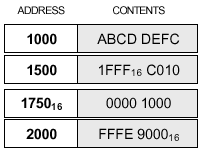|

Some of the following questions are based
on the Main-memory Map as depicted above.
(a) What is the word size of main memory? Explain your answer. [2]
WORD
SIZE = 32 BITS [1](Because the word comprises two Hexidecimal values)
[1]
(b) There are various criteria to gauge performance of memory components,
two
examples are Transfer rate and Memory cycle time. What is the third
performance
criterion and how does it differ for random-access and non-random-access
memory types? [3]
For random access memory, this is the time
taken to perform a
read or write operation,[1] that is, the time taken from the instant
that an address is presented to the memory to the instant that data
have been stored or made available for use. [1] For non-random
access memory, access time is the time it takes to position the
read-write mechanism at the desired location. [1]
Award marks for these or other valid points.
(c) Given this assembly instruction: MOV AX, @1750
(i) Identify the instruction format. [1]
2-ADDRESS FORMAT [1]
(ii) Identify the addressing technique. [1]
INDIRECT ADDRESSING TECHNIQUE [1]
(iii) Write the steps of the execute-cycle. [3]
IR  DC
DC
MAR  1750 1750
MAR  ADDRESS LINES
ADDRESS LINES
READ CONTROL LINE IS ASSERTED
MAR  1000
1000
MAR  ADDRESS LINES
ADDRESS LINES
READ CONTROL LINE IS ASSERTED
MEM1000 ® DATA LINES ® MBRABCDDEFC
Award [3] for a perfect description; [2] if there are one or two
defects; [1] if there are significant defects but some of the right
ideas are still present.
(d) With the aid of a diagram, explain how in Virtual-memory, a page
is loaded from secondary memory to a main-memory location. Your answer
should include
explanations of the terms Page Fault, Demand Paging, and Page Table.
[5]
(An appropriate diagram is required with
suitable explanations)
[up to 2]
Demand paging will call for a page to be loaded into main memory.
[1] It will look inside of the page table to see if the page resides
there (much similar to a cache operation and the tag table). [1] If
the page is not there this is referred to as a Page Fault, [1] and
then the respective page is loaded in from secondary memory.
The virtual address is thus translated to a physical address via
HW/SW to a location in main memory. [1]
(Award marks for these or other relevant points)
|